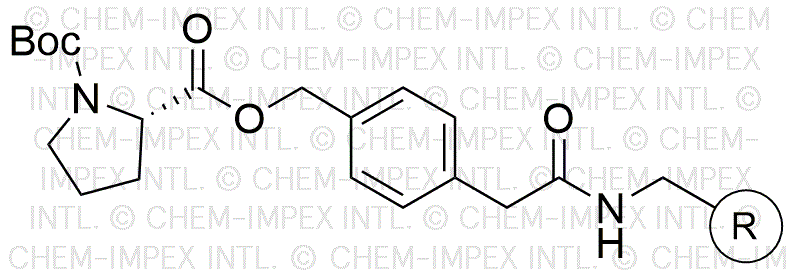Boc-L-proline 4-oxymethylphenylacetamidomethyl is widely utilized in research focused on:
- Peptide Synthesis: This compound serves as a key building block in the synthesis of peptides, particularly in the development of pharmaceuticals. Its unique structure enhances the stability and efficacy of peptide drugs.
- Drug Development: It plays a crucial role in the design of new therapeutic agents, especially in the treatment of various diseases. Researchers leverage its properties to create more effective drug candidates.
- Bioconjugation: The compound is used in bioconjugation processes, allowing for the attachment of biomolecules to drugs. This enhances drug delivery systems, improving targeting and reducing side effects.
- Research in Organic Chemistry: It is frequently employed in organic synthesis as a versatile intermediate, facilitating the creation of complex organic molecules with specific functionalities.
- Material Science: Its applications extend to the development of new materials, where it contributes to the formulation of polymers and coatings with enhanced properties, such as improved durability and resistance.
General Information
Properties
Safety and Regulations
Applications
Boc-L-proline 4-oxymethylphenylacetamidomethyl is widely utilized in research focused on:
- Peptide Synthesis: This compound serves as a key building block in the synthesis of peptides, particularly in the development of pharmaceuticals. Its unique structure enhances the stability and efficacy of peptide drugs.
- Drug Development: It plays a crucial role in the design of new therapeutic agents, especially in the treatment of various diseases. Researchers leverage its properties to create more effective drug candidates.
- Bioconjugation: The compound is used in bioconjugation processes, allowing for the attachment of biomolecules to drugs. This enhances drug delivery systems, improving targeting and reducing side effects.
- Research in Organic Chemistry: It is frequently employed in organic synthesis as a versatile intermediate, facilitating the creation of complex organic molecules with specific functionalities.
- Material Science: Its applications extend to the development of new materials, where it contributes to the formulation of polymers and coatings with enhanced properties, such as improved durability and resistance.
Documents
Safety Data Sheets (SDS)
The SDS provides comprehensive safety information on handling, storage, and disposal of the product.
Product Specification (PS)
The PS provides a comprehensive breakdown of the product’s properties, including chemical composition, physical state, purity, and storage requirements. It also details acceptable quality ranges and the product's intended applications.
Certificates of Analysis (COA)
Search for Certificates of Analysis (COA) by entering the products Lot Number. Lot and Batch Numbers can be found on a product’s label following the words ‘Lot’ or ‘Batch’.
Numéro de catalogue
Numéro de lot/série
Certificates Of Origin (COO)
This COO confirms the country where the product was manufactured, and also details the materials and components used in it and whether it is derived from natural, synthetic, or other specific sources. This certificate may be required for customs, trade, and regulatory compliance.
Numéro de catalogue
Numéro de lot/série
Safety Data Sheets (SDS)
The SDS provides comprehensive safety information on handling, storage, and disposal of the product.
DownloadProduct Specification (PS)
The PS provides a comprehensive breakdown of the product’s properties, including chemical composition, physical state, purity, and storage requirements. It also details acceptable quality ranges and the product's intended applications.
DownloadCertificates of Analysis (COA)
Search for Certificates of Analysis (COA) by entering the products Lot Number. Lot and Batch Numbers can be found on a product’s label following the words ‘Lot’ or ‘Batch’.
Numéro de catalogue
Numéro de lot/série
Certificates Of Origin (COO)
This COO confirms the country where the product was manufactured, and also details the materials and components used in it and whether it is derived from natural, synthetic, or other specific sources. This certificate may be required for customs, trade, and regulatory compliance.

